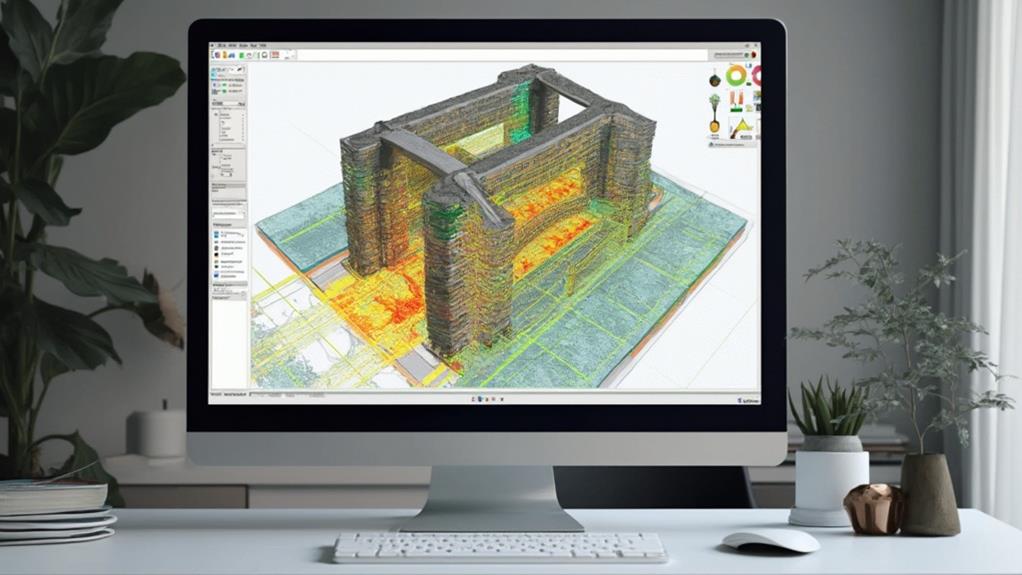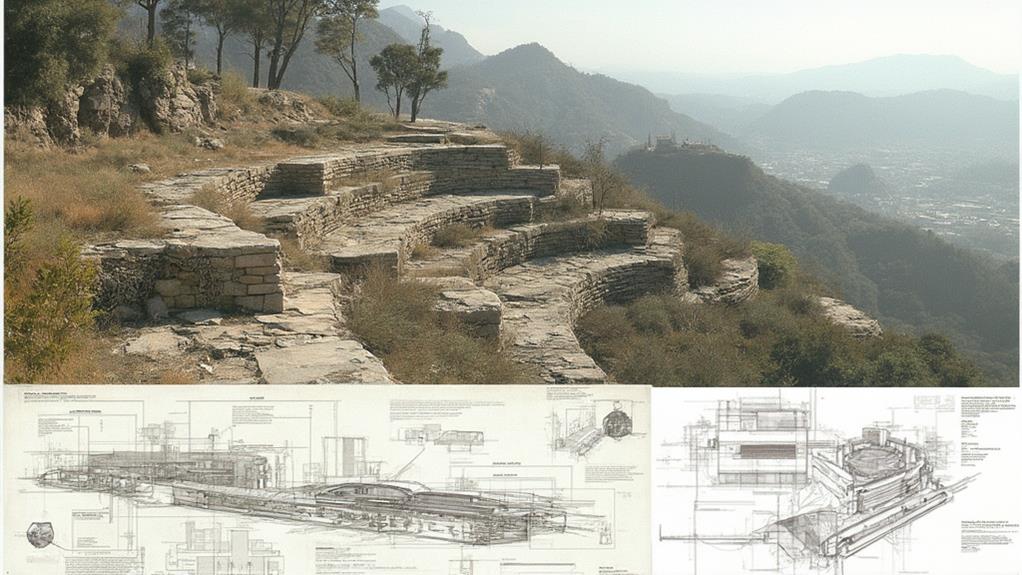Designing effective retaining walls using specialized software involves utilizing sophisticated tools that enhance analysis and precision. Key software offers advanced 3D modeling capabilities, integrating seamlessly with BIM systems to visualize complex geometries accurately. It encompasses an extensive materials library, aiding in precise material optimization, while ensuring compliance with standards from bodies like ACI and Eurocode. Selection criteria focus on accurate soil pressure and load analysis, a user-friendly interface, and compatibility with other engineering tools. Such software accelerates the design process, yielding cost-effective and reliable outcomes while ensuring safety and aesthetic integration. Further exploration reveals more insightful techniques and technologies.
Table of Contents
ToggleWalls Contractor Highlights
- Utilize advanced 3D modeling capabilities for accurate visualization and design of complex retaining wall geometries.
- Apply integrated design standards like ACI and Eurocode for compliance and safety in retaining wall construction.
- Optimize material usage by leveraging software's precise material estimation and prediction tools.
- Accelerate the design process with automated functions, streamlining workflows and reducing manual labor.
- Enhance collaboration and communication through software integration with BIM and other engineering tools.
Structural Design Software

Structural design software serves as an indispensable tool in the engineering and construction industries, offering key features such as all-encompassing analysis modules, efficient modeling capabilities, and user-friendly interfaces tailored to streamline the design process of retaining walls.
When selecting such software, critical criteria include the accuracy of simulation results, ease of integration with existing design and engineering workflows, and the software's ability to comply with current construction codes and standards, ensuring that all designs adhere to safety and regulatory requirements.
These tools are particularly valuable for designing complex retaining wall systems such as gabion walls and large-scale concrete structures, which require precise engineering calculations. Additionally, successful software should seamlessly interface with established design standards, allowing engineers to confidently apply these tools to various project specifications and constraints.
Key Features Overview
In today's fast-paced engineering landscape, having the right tools for structural design is indispensable. Structural design software offers a suite of key features to enhance the efficiency and accuracy of retaining wall projects.
Paramount among these is the ability to conduct extensive analysis and design, integrating various geotechnical and structural components in a coherent manner. This software typically supports multiple retaining wall types, accommodating the diverse requirements of projects across varied terrains.
Advanced modeling capabilities are pivotal, allowing engineers to create precise representations of potential designs. These features include three-dimensional rendering, enabling the visualization of complex geometries and aiding in the identification of potential structural issues.
Additionally, the inclusion of a comprehensive materials library within the software provides engineers immediate access to information on material properties, guaranteeing the designs adhere to necessary strength and durability criteria.
Seamless integration with Building Information Modeling (BIM) software represents another critical feature, fostering enhanced collaboration across multidisciplinary teams. This capability ensures that changes made within the retaining wall design are reflected across all project documentation, maintaining consistency and reducing errors.
Ultimately, these features empower engineers, creating a unified community that thrives on precision and reliability.
Software Selection Criteria
Selecting the appropriate software for structural design is an intricate decision, especially when tasked with the demands of retaining wall projects. A successful selection process should meticulously evaluate various parameters that can influence the overall effectiveness, accuracy, and usability of the software.
The software must offer precise calculation capabilities to handle soil pressure, load analysis, and material specifications, guaranteeing the design aligns with the desired performance criteria. In addition, user-friendliness plays a pivotal role in enhancing workflow efficiency, reducing learning curves, and ensuring seamless operation within a multidisciplinary team.
Accessibility to robust support and resources further contributes to successful implementation, allowing designers to access technical assistance and enhance software utility through educational materials and community forums. Compatibility with other engineering tools can profoundly impact integration within existing workflows, minimizing disruptions and maximizing productivity. Moreover, cost-effectiveness cannot be overlooked, as projects necessitate fiscal responsibility alongside superior outcomes.
Workshop discussions often highlight the importance of extensive analysis features, such as stability assessments and design options that allow for creativity while adhering to safety standards. Evaluating each solution through these criteria ensures project stakeholders feel supported and confident in their choice, fostering a collaborative and inclusive design environment.
Integration With Design Standards
Adhering to established design standards is imperative in structural engineering to guarantee, warrant, or safeguard safety, compliance, and reliability. Integration with these standards when utilizing structural design software is a critical component of engineering practice, fostering a sense of confidence and security among industry professionals.
The software serves as a conduit to seamlessly incorporate guidelines such as those from the American Concrete Institute (ACI) or Eurocode, ensuring that every aspect of the retaining wall design is meticulously aligned with legislative and technical mandates.
Benefits

Utilizing software for designing retaining walls presents a multitude of advantages, including enhanced structural analysis that enables engineers to assess various load conditions and environmental factors with precision. The software streamlines the design process substantially, reducing the time traditionally required while simultaneously supporting precise material estimation to optimize resource utilization.
Retaining wall functions, such as preventing erosion and creating usable areas, can be more effectively incorporated into the design through specialized software tools. Additionally, it facilitates cost-effective construction planning by allowing for scenario analysis and budget forecasting, thereby ensuring projects are completed within financial constraints.
Enhanced Structural Analysis
The proficiency of modern software in conducting enhanced structural analysis offers substantial benefits in the design of retaining walls. This technological advancement allows engineers to explore deeper into the structural integrity and performance predictions of retaining walls under various conditions.
Expanded structural analysis tools incorporate advanced algorithms and computational power to simulate complex geological interactions and loading scenarios, providing insights that were previously difficult to obtain. This leads not only to safer designs but also optimizes material usage, reducing costs and environmental impact.
Key benefits include:
- Precision in Load Calculations: Software can accurately predict how retaining walls will respond to different types of loads and stresses, ensuring robustness.
- Material Optimization: Engineers can design walls that use just the right amount of materials, balancing strength and efficiency.
- Risk Mitigation: Identifying potential failure points in advance helps in proactive planning and increases the safety of construction projects.
- Enhanced Visualization: 3D simulation capabilities allow for a more complete understanding of the wall's behavior in a virtual environment.
- Improved Compliance: Detailed analysis supports adherence to industry standards and regulations, fostering confidence among stakeholders.
Time-Saving Design Process
Adopting cutting-edge design software vastly streamlines the time-consuming process of developing retaining walls. By leveraging advanced computing technology, engineers and designers can efficiently manage intricate details, ensuring each step of the project is well-coordinated and expeditiously executed. This approach mitigates the traditional barriers of manual labor, allowing professionals more freedom to explore innovative solutions and offer superior service to clients. Streamlined operations nurture a collaborative workplace, fostering an environment where team members feel connected and integral to the project's success.
The software's intuitive interfaces and streamlined workflows reduce time spent on repetitive tasks, enabling teams to devote more energy to critical thinking and creativity. Automated design functions accelerate the once laborious processes of drafting and editing, producing precise designs with unmatched speed and accuracy. By refining these processes, design software not only enhances productivity but also builds confidence among stakeholders in delivering timely, high-quality outcomes.
Ultimately, integrating cutting-edge software into retaining wall design exemplifies a commitment to efficiency and excellence. Engineers, architects, and construction managers are empowered to meet tight deadlines without sacrificing quality, strengthening the bonds of trust and reliability that are fundamental to sustaining professional relationships in the industry.
Precise Material Estimation
Accurately estimating materials is pivotal in the design and construction of retaining walls, often determining both the project's feasibility and cost-effectiveness. Through the precision that specialized software affords, designers and engineers can make informed decisions and reduce waste, creating structures that are both resilient and resource-efficient. This technological advancement offers a profound sense of belonging within the engineering community by aligning individual projects with broader industry standards.
Key benefits include:
- Cost Prediction: By calculating material needs precisely, it becomes possible to forecast project costs with greater accuracy, minimizing fiscal risk.
- Resource Optimization: Detailed assessments guarantee all materials are utilized effectively, leading to reduced excess and environmental impact.
- Design Adjustments: Real-time data enables swift adjustments to designs, allowing for enhanced customization and innovation while maintaining structural integrity.
- Supplier Relationships: Accurate estimations help in fostering strong relationships with suppliers by ordering exact quantities, consequently supporting a reliable supply chain.
- Schedule Efficiency: By precisely calculating materials, projects can stay on schedule, avoiding delays associated with shortages or over-ordering.
These advantages underscore the importance of precise material estimation, forging pathways for collaboration and excellence in retaining wall construction that members of this professional domain can be proud to achieve together.
Cost-Effective Construction Planning
Harnessing precise material estimation sets the stage for cost-effective construction planning in retaining wall projects. Accurate predictions allow for streamlined budgeting and resource allocation, essential in today's competitive construction environment.
An efficient planning process not only helps adhere to financial constraints but also fosters a sense of collective achievement among project stakeholders. By utilizing software-driven simulations, teams can better forecast costs related to materials, labor, and time, facilitating transparent communication and trust among all involved.
Incorporating cost-effective strategies guarantees that resources are aligned with project goals, ultimately enhancing the workflow and reducing waste. For example, detailed projections allow project managers to negotiate better pricing with suppliers or optimize labor schedules, leading to significant savings. Additionally, these practices contribute to meeting sustainability goals by minimizing material wastage, which resonates with environmental conscientiousness increasingly valued in our industry.
Moreover, astute planning translates to lasting benefits for communities by ensuring infrastructural resilience and safety. Retaining walls constructed with foresight provide not just functional benefits but also aesthetic integration into the surrounding environment, supporting the identity and cohesiveness of community spaces. As project success is shared, cost-effective planning becomes a cornerstone of inclusive development.
Case Study: Successful Wall Project

In our examination of a successful retaining wall project, we explore project planning strategies, innovative design approaches, and insights from real-world implementation, demonstrating how these elements interact to contribute to a project's success. The project utilized advanced software solutions to streamline complex calculations and optimize design efficiency, while also accommodating site-specific challenges. Below is a summary of key components associated with the undertaking:
| Aspect | Strategy or Approach | Outcome |
|---|---|---|
| Project Planning Strategies | Use of predictive analytics | Enhanced timeline accuracy |
| Design Approaches | Integration of 3D modeling technology | Improved design precision |
| Implementation Insights | Real-time monitoring and adjustments | Increased adaptability on-site |
| Overall Impact | Software-aided collaboration efforts | Streamlined team communication processes |
Project Planning Strategies
Effective project planning strategies are integral to the success of retaining wall projects, as evidenced in a recent case study. The project highlighted several key components that guaranteed its completion on time and within budget, enhancing the collaborative spirit and efficiency among the stakeholders involved. Emphasizing detailed preliminary analysis and stakeholder engagement from the onset laid a sturdy foundation for the project's trajectory.
Key planning strategies identified in the case study included:
- Comprehensive Site Analysis: Identifying soil types, water table levels, and existing structures confirmed tailored design solutions.
- Stakeholder Involvement: Regular meetings with contractors, engineers, and the community encouraged open communication and proactive problem-solving.
- Resource Allocation: Strategically sourcing materials and manpower optimized the schedule without compromising quality.
- Risk Assessment: Anticipating potential issues such as weather disruptions and logistical challenges mitigated their impact.
- Software Utilization: Leveraging advanced project management software maintained alignment on timelines and budget forecasts.
These strategies underscore the importance of disciplined planning, promoting an environment where every team member feels valued and invested in delivering a successful outcome. The case study illustrates how meticulous planning fosters a sense of unity and shared purpose, critical for executing a project seamlessly from conception through completion.
Innovative Design Approaches
While the foundational elements of project planning set the stage for success, the adoption of innovative design approaches distinguishes remarkable retaining wall projects. Such ingenuity was manifest in a project undertaken by EarthBuild Solutions, which transformed the landscape of an urban coastal area, characterized by complex soil strata and fluctuating water tables.
Employing advanced geotechnical software, the team applied a hybrid design methodology, merging traditional engineering principles with contemporary computational modeling techniques. This approach allowed for precise calculations of load-bearing capacities and optimizations in material use, ensuring a sustainable and resilient structure.
In this project, parametric modeling tools proved invaluable, enabling designers to simulate various scenarios and predict the interaction of the retaining wall with dynamic environmental conditions. By incorporating real-time data from site sensors, the software facilitated adaptations in the design phase before challenges arose during construction. The successful execution of this project underscored the utility of integrating cutting-edge technology with established engineering practices.
This synergy not only enhanced design accuracy but also fostered a sense of inclusiveness and collaboration among stakeholders, as the intuitive interface of the software bridged communication gaps between engineers, clients, and regulatory bodies.
Real-World Implementation Insights
Despite the intricate challenges presented by the project site, the successful implementation of the retaining wall by EarthBuild Solutions serves as an exemplary model of engineering excellence. Facing severe topographical inclinations and variable soil conditions, EarthBuild employed advanced design software to navigate potential structural hurdles. The project exemplifies strategic integration of technology and human expertise to create robust retaining walls capable of withstanding environmental pressures.
The following key insights offer a deeper understanding into the seamless execution of this project:
- Comprehensive Site Analysis: Detailed assessments guaranteed accurate capture of site-specific data, facilitating targeted solutions for unique site conditions.
- Adaptative Use of Technology: EarthBuild utilized state-of-the-art software for precision modeling, optimizing the wall design to counteract geographic and geotechnical challenges.
- Material Selection: Prioritization of materials responsive to environmental needs provided both durability and aesthetics, aligning with modern sustainable practices.
- Stakeholder Engagement: Collaborative communication with stakeholders throughout the design and construction phases assured alignment with project goals and community expectations.
- Proactive Risk Management: Systematic identification and mitigation of potential risks safeguarded structural integrity and overall project timeline.
This strategic execution not only reinforces EarthBuild's commitment to efficiency and excellence but also fosters a sense of reassurance and unity among clients and stakeholders, assuring mutual trust and continued collaboration.
Walls Contractor FAQ
What Factors Should Be Considered During Site Assessment for Retaining Wall Projects?
When evaluating sites for retaining wall projects, consider factors such as soil type, slope stability, drainage systems, load-bearing requirements, environmental impact, and local regulatory compliance. A thorough examination guarantees structural safety and community integration, fostering inclusive development.
How Does Soil Type Impact the Design of a Retaining Wall?
Soil type vastly influences retaining wall design by affecting stability, drainage, and load-bearing capacity. Different soil characteristics, such as cohesion, friction angle, and moisture retention, require tailored solutions to guarantee a durable and effective retaining structure.
What Are Common Materials Used in Constructing Retaining Walls?
Retaining walls are constructed using materials like concrete, stone, wood, and brick, each offering unique benefits such as durability and aesthetics. Selecting the appropriate material guarantees structural integrity and complements the surrounding environment's architectural style.
How Can I Ensure Accurate Data Input for Software Simulations?
Ensuring accurate data input for software simulations involves thoroughly understanding project specifications, verifying geotechnical data, and maintaining clear communication with stakeholders. Collaborative efforts enhance data reliability, ultimately fostering a sense of shared responsibility and community among all project participants.
What Are the Cost Implications of Using Design Software for Retaining Walls?
While employing design software for retaining walls can initially seem costly, the long-term benefits include precision, reduced labor, and fewer errors. These advantages far outweigh initial expenses, providing a sense of belonging to a community committed to excellence.







